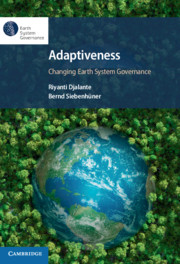Book contents
- Adaptiveness
- Adaptiveness
- Copyright page
- Contents
- Figures
- Tables
- Contributors
- Foreword
- Preface and Acknowledgements
- 1 On Adaptiveness
- 2 Synthesising and Identifying Emerging Issues in Adaptiveness Research within the Earth System Governance Framework (1998–2018)
- 3 Climate Change Adaptive Capacity Assessments
- 4 Assessing the Adaptive Capacity of Collaborative Governance Institutions
- 5 The Marine Debris Nexus
- 6 Synergies and Trade-Offs between Climate Change Adaptation and Mitigation across Multiple Scales of Governance
- 7 Lock-Ins in Climate Adaptation Governance
- 8 Governance and Climate Change Mitigation and Adaptation in Conflict-Affected Countries of Central Africa
- 9 Policy Tools and Capacities for Adaptiveness in US Public Land Management
- 10 Adaptiveness in Earth System Governance
- Index
- References
1 - On Adaptiveness
Changing Earth System Governance
Published online by Cambridge University Press: 22 June 2021
- Adaptiveness
- Adaptiveness
- Copyright page
- Contents
- Figures
- Tables
- Contributors
- Foreword
- Preface and Acknowledgements
- 1 On Adaptiveness
- 2 Synthesising and Identifying Emerging Issues in Adaptiveness Research within the Earth System Governance Framework (1998–2018)
- 3 Climate Change Adaptive Capacity Assessments
- 4 Assessing the Adaptive Capacity of Collaborative Governance Institutions
- 5 The Marine Debris Nexus
- 6 Synergies and Trade-Offs between Climate Change Adaptation and Mitigation across Multiple Scales of Governance
- 7 Lock-Ins in Climate Adaptation Governance
- 8 Governance and Climate Change Mitigation and Adaptation in Conflict-Affected Countries of Central Africa
- 9 Policy Tools and Capacities for Adaptiveness in US Public Land Management
- 10 Adaptiveness in Earth System Governance
- Index
- References
Summary
The earth system is being transformed by human activities. The complex societal, technological, and environmental changes underway require governance systems that can anticipate, manage, and help steer these changes along more sustainable trajectories. A decade ago the Earth System Governance (ESG) Project proposed that adaptiveness is one of the key attributes and goals of governance in these situations. Adaptiveness is an umbrella concept encompassing and related to adaptive management and governance, adaptive capacity, vulnerability, resilience, robustness, and social learning. As part of the ESG Project Harvesting Initiative, this book aims to take stock and review a decade of research progress surrounding these themes. Its key research question is: How has adaptiveness, as an umbrella concept, been developed and applied in the context of earth system governance in the first decade after its inception, and what insights and practical solutions has it yielded? Here this ambitious question is divided into four specific questions based on the ESG Project 2009 Science Plan: (1) What are the politics of adaptiveness? (2) Which governance processes foster adaptiveness? (3) What attributes of governance systems enhance capacities to adapt? (4) How, when, and why does adaptiveness influence eartth system governance?
Keywords
- Type
- Chapter
- Information
- Adaptiveness: Changing Earth System Governance , pp. 1 - 25Publisher: Cambridge University PressPrint publication year: 2021
References
- 1
- Cited by

